
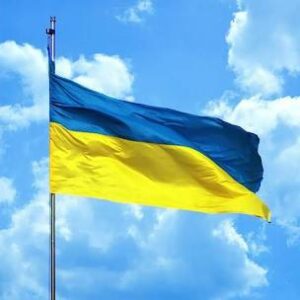
Please pray for the needlessly suffering people of Ukraine and the needlessly starving people of Gaza.
1) Why the Surge of Young People into the Orthodox Church?
Last week I asked any here present to share your opinions about why this is happening – especially why so many young men are being drawn to the Orthodox Church.
Well, I was almost overwhelmed by the two (count them: two. 2, δύο, II,两) Comments, plus one Suggestion that came in. Hey, people, that was not exactly a surge of responses!
These already appeared in last week’s Comments, but inasmuch as they are thoughtful and interesting, I’ll share them here as well.
1 This is the opinion of a good friend of mine who is nearly my age (“experienced”, shall we say?), based on what he has observed over the years.
“Father, I believe the “surge” is real at Annunciation (Wauwautosa) and at St. Herman’s (West Bend), and it is more young men than others. I attribute at least some it to multiple dedicated/talented Orthodox Priests, not Orthodoxy as intellectually faith inspired in the abstract; and also I believe the Orthodox Parishioners themselves in our area seem more welcoming than a generation or more ago, letting go of the attitude that ‘these are our beliefs, we are content, and if others aren’t sort of spontaneously somehow interested, well so-what / who-cares?”
2 This excellent analysis comes from a young man in England, passed on to us by his pastor.
“I think the primary factor for many of us who have been drawn to the Orthodox Church has been the failings of the heterodox churches. After a low point in life I decided to turn to Christ, and not knowing what Orthodoxy is, I ‘tried out’ a whole range of churches. I found them all to be lacking. Some have introduced innovations such as female clergy, others fall either into extreme charismaticism or dry and soulless intellectualism. When I first entered an Orthodox church everything felt so natural – an experience I’ve heard from many others – of finally feeling at home. I finally found a place that was rich in history, full of meek and pious Christians, and infinitely mysterious.
“Another factor not to dismiss is the role of the Internet, which wasn’t particularly influential in my conversion – but there are some great priests ministering online, and I can see how for many others this would be a major pathway to discovering the beauty and truth of Orthodoxy.
“Many of us in this age recognise the new depths of depravity that our society steps into day after day, and for me and for many I know Orthodoxy has been a result of seeking the way out of these snares.”
3 Here’s a suggestion from a priest who wrote in:
“Presbytera Frederica Matthewes-Greene has written an excellent article on this. Seek and you shall find.”
I’ve sought but haven’t found! Father John, which book is this?
_______________________
I really want more opinions, so here’s what I’m going to do: I’m going to contact about twenty young people whom I know, who have fairly recently come to the Orthodox Church, and ask them to tell us, in writing, what drew them here. Because I know them personally, maybe they’ll feel guilty if they don’t respond! Then at some time near in the future, I’!l publish what they say.
2) The Holy Martyr Deacon Lawrence of Rome
Above I described him as “young”. He was about 33 – very young by my standards. Another Orthodox “smart aleck”, at least in the eyes of the imperial authorities. I love this story, gruesome as the ending is. (You’ll notice, below, what he’s holding.)
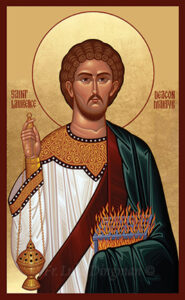
Commemorated on August 10
Lawrence is thought to have been born on December 31, AD 225, in the region of Aragon in what is now southeast Spain. There he met a great teacher from Greece, Sixtus, and traveled with him to Rome. When Sixtus became Pope of Rome in 257, he appointed the young Lawrence, who was only 32, as deacon and then as Archdeacon of Rome, the first among seven deacons who served in the cathedral church. The office of Archdeacon was of great importance: Lawrence cared for the treasury and riches of the Church and the distribution of alms to the needy.
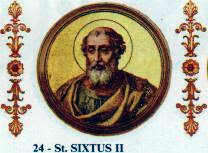
The Church was seen by some as a direct threat to the Empire, because of its rapid growth and because Christians refused to worship the gods, the cornerstone of public society. Only a year later, at the beginning of August 258, the Emperor Valerian issued an edict that all bishops, priests and deacons be put to death. On August 6 Pope Sixtus II was captured while celebrating the Liturgy. As he was taken to the place of his execution, Archdeacon Lawrence ran to him and was heard crying “Where are you going, Holy Father, without your son? Where, dear Bishop, without your Archdeacon?” Pope Sixtus told Lawrence to prepare for his own death, as well.
Lawrence was then arrested, and directed to hand all the Church’s treasures over to the Emperor. He begged for and was granted three days’ time to collect the riches.
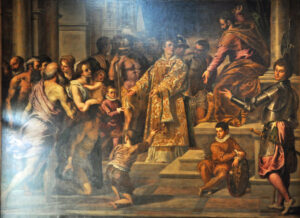
Quickly he distributed all the Church’s treasures to the needy, and on the third day gathered the poor of the city to go with him to the prefect. When the prefect demanded, “Where are the treasures?” Archdeacon Lawrence pointed to the poor. “Here”, he cried, ”are the riches of the Church”.
You can imagine that the prefect was not impressed. He ordered that Lawrence immediately be executed in a special and novel way. They heated up a grid-iron and tied the Archdeacon to it, in order to roast him to death. Shortly before Lawrence died, he cried out, “Turn me over. I’m done on this side.”
Saint Lawrence was martyred on August 10, 258. He was about 33 years old.
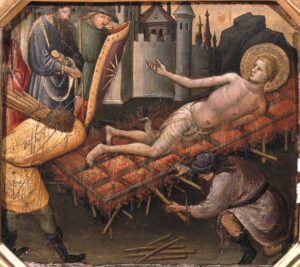
According to the Almanac of Filocalus (AD 354) the Holy Martyr Archdeacon Lawrence was buried in the Catacomb of Cyriaca on the Via Tiburtina (just northeast of Rome) near the tombs of the Martyr Justin the Confessor and the great theologian, Bishop Hippolytus.
Emperor Constantine I is said to have erected a small oratory in honor of Lawrence, which in better times became a station on the itineraries of the graves of the Roman martyrs.
As Tertullian wrote, “The Church grew on the blood of the martyrs.” It was because of brave men and women like Lawrence that the Church of Christ endured, more than endured. People asked, “Who is this Jesus Christ, that people will suffer and die for Him?”
If you haven’t heard the story of Saint Lawrence before, I wager you will now remember it – this young Archdeacon, who lived and died with courage, with grace, with (dare I use the word?) with class. “Let your speech always be with grace, seasoned with salt, that you may know how you ought to answer each one.” Colossians 4:6
Holy Martyr Lawrence, pray to Christ our God for the salvation of our souls.
______________
Just a few more things about Saint Lawrence:
According to various sources, he is third patron of the city of Rome (after Peter and Paul), also patron of the poor and indigent, of firefighters, of cooks (really?), of those to whom fire means particular harm (librarians, archivists, miners, and the like) and of comedians – surely you can figure out why.
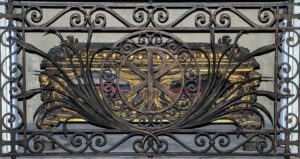
A modern Roman Catholic scholar (best left nameless), one of those people who love to de-mystify things, contends that the story of Lawrences’s death is untrue, because the Romans executed people by crucifixion. This neglects two points: 1 For special cases, extraordinarily gruesome means were sometimes concocted: People were thrown into red-hot brass bulls – or do you know about “Saint Catherine’s Wheel”? which literally ripped people apart, used in Prussia as late as the mid-Nineteenth Century. 2 Saint Lawrence’s grid-iron still exists, to be found at the Minor Basilica of San Lorenzo in Lucina, the site of his martyrdom. Why would the Church have found an old grill and then made up the story? I trust ancient traditions far more than modern scholars.
Saint Lawrence Greek Orthodox Church, Felton, California claims (correctly, so far as I can find) to be the only Orthodox Church named after Saint Lawrence of Rome.

So far as I know, Lawrence is the only saint to have a major river and gulf named after him. Do you know any others?
Here is a moving hymn (too lengthy to include here) in honor of Saint Lawrence, “Prepare for him a bed of coals”, written by Prudentius in the Fourth Century: https://gloriaromanorum.blogspot.com/2018/08/prepare-for-him-bed-of-coals.html
Did you know: In Boise, Idaho, there is a restaurant called “Saint Lawrence Gridiron”, known for its “smoked meats and barbecue”. Rated four stars out of five. Thanks for the invitation, it’s very kind of you, but… … … … I don’t think so.
3) Finally, to pull Points One and Two of this Post together:
Here, I believe, is one thing that is drawing young people (especially young men?) into the Holy Orthodox Church today. They want a Church that challenges them. Not martyrdom like Saint Lawrence, God willing, but something more than easy “comfortable Christianity”.
Below (in case you can’t make it out): the appointed twenty-one long Holy Week services. I once saw a t-shirt which read “I survived Orthodox Holy Week”.
 .
.
Next Week: What actually became of Mary, the Mother of God?
Week after Next: What I’ve learned in my 87 years. (short Post)
Sources of information about Saint Lawrence: orthodoxwiki.org, wikipedia.com, catholiconline.org. newadvent.org